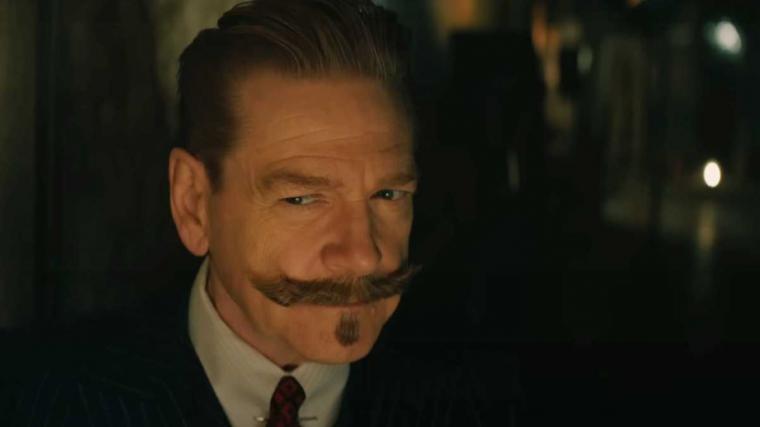
Kenneth Branagh in A Haunting in Venice
A HAUNTING IN VENICE
Is it possible that, regarding his previous Hercule Poirot mysteries, Kenneth Branagh not only read critiques of those films, but actively took their criticisms to heart?
Although I greatly enjoyed 2017's Murder on the Orient Express and mostly liked last year's Death on the Nile, I also couldn't argue with what numerous reviewers considered deal-breaking faults. The obvious CGI and matte effects were overtly artificial and tacky. The occasional attempts to turn Agatha Christie's fastidious Belgian sleuth into an action hero bordered on the embarrassing. The employment of franchise-familiar Hollywood A-listers – principally Johnny Depp and Gal Gadot – merely felt like a sop to box-office concerns. And not for nothing, but both Orient Express and Death on the Nile were already adapted for the screen in the 1970s, and were Academy Award winners, to boot. If series director/star Branagh and screenwriter Michael Green were venturing down this particular avenue, couldn't they collaborate on a Poirot mystery that audiences were likely less familiar with? For Pete's sake, Christie plunked the guy into more than 80 of 'em.
With his third showcase for Christie's elaborately mustachioed detective, A Haunting in Venice, I'm happy to report that Branagh has seemingly addressed every one of those complaints. While the visuals are eye-catching and oftentimes deliberately outlandish, the computerized fakery is kept to a discreet minimum. Branagh's newly retired Poirot is no longer asked to perform questionable feats of derring-do; when he's really exerting himself here, he's taking a mild jog down a hallway. Even though there are still potential killers and victims aplenty, if slightly fewer than in the past, the starriness of the ensemble isn't overwhelming or off-putting, with the most familiar faces being those of Tina Fey, Michelle Yeoh, and Yellowstone's Kelly Reilly. (Admirers of Branagh's Oscar-winning Belfast will also delight in seeing Jamie Dornan and wunderkind Jude Hill again cast as father and son.) And most enticingly, A Haunting in Venice has not only been adapted from one of Christie's lesser-known works – 1969's Hallowe'en Party – but has been so dramatically refashioned that its plot, by all accounts, barely resembles the novel's. At last: a brand-new Poirot mystery for moviegoers to solve! To my eyes, and despite the fun previously provided, these are all changes for the better, and what results is not only Branagh's best Agatha Christie yet, but perhaps his thus-far-finest directorial achievement wholly unconnected to William Shakespeare.
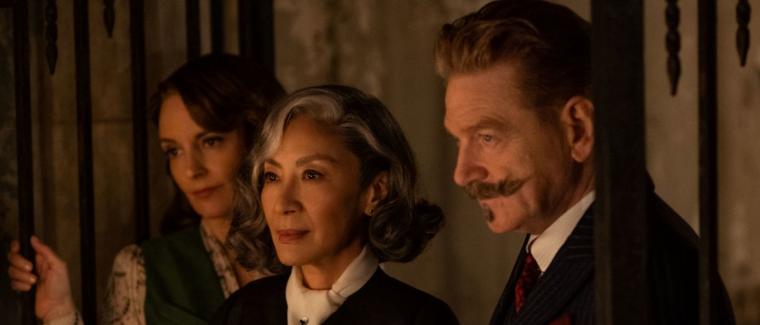
As the film opens, the year is 1947, and Poirot is living in self-imposed exile in Italy, no longer accepting cases and tended to only by his gruffly efficient bodyguard Vitale (Riccardo Scamarcio). Yet with the arrival of an old friend, Tina Fey's American mystery writer Adriane Oliver, Poirot receives an invitation he can't refuse: to join Adriane at a Venetian séance hosted by opera singer Rowena Drake (Kelly Reilly), and debunk the purported psychic gifts of the medium (Michelle Yeoh's Joyce Reynolds) hired to make contact with Rowena's deceased daughter. It isn't a spoiler to reveal that the detective quickly does prove the chicanery behind Joyce's act, much the way Benoit Blanc made immediate mincemeat of his host's planned murder party in Glass Onion. But A Haunting in Venice's chief mysteries actually begin after the ruse is uncovered, because soon enough there's a dead body, a palazzo full of suspects, and the question of whether Rowena's daughter died as a result of suicide, murder, or supernatural forces that, to the adamant logician Poirot, are beginning to seem all too plausible.
When I first saw the movie's trailer earlier this year, I was moderately surprised that Branagh was delivering another Christie so soon after Death on the Nile, and that, given that film's underwhelming grosses, he was allowed to deliver one at all. (To be fair, Nile was originally scheduled for a 2019 release before production delays and COVID got in the way; 20th Century Studios likely gave Branagh the green light, and the dough, before the film faltered in early 2022.) Yet I was even more shocked by the tenor of the Haunting in Venice trailer, which didn't suggest a Hercule Poirot so much as a gazillionth entry in the Conjuring franchise. While the style and breadth of Branagh's – and Suchet's, and Ustinov's, and Finney's … – facial hair has changed over the years, this Christie protagonist has always lived in a recognizably real world, if one housing a freakish number of murders in Poirot's vicinity. But here was the detective beset by visions and faraway voices and what looked to be the corpse from The Ring reflected in his bathroom mirror. How was screenwriter Green going to rationalize the inclusion of these traditional fright-flick tenets without trashing more than 100 years of literary, radio, stage, and cinematic history in the process?
The answer is: pretty effectively. I can't say with 100-percent certainty that all of the ghostly sights and sounds are explained via airtight logic, though I'll be glad to analyze further on eventual repeat viewings. Yet the supernatural elements in Rowena's haunted palazzo are at least rationalized with moderate believability, and they do wonders in helping to humanize Branagh's Poirot. Although it's never made expressly clear what initiated the Belgian crime-solver's retirement, references to his war traumas, his late wife Katherine, and his many years of exacting justice for the dead make it evident that Poirot no longer has room in his head or heart for the possibility of miracles. Consequently, opening himself to the idea of ghostly interference means opening himself to the idea of the miraculous, of the divine, and it's thrilling watching Poirot reclaim his purpose while worrying that he's losing his mind. All of Branagh's Christies are steeped in sadness – more so than Agatha Christie herself perhaps intended. But this approach gives Branagh loads of varying emotional registers to play beneath his stoic facade, and the occasional jump scares do more than shake up Poirot. They shake up an audience presumably well-versed in the mechanics of prototypical drawing-room mysteries.
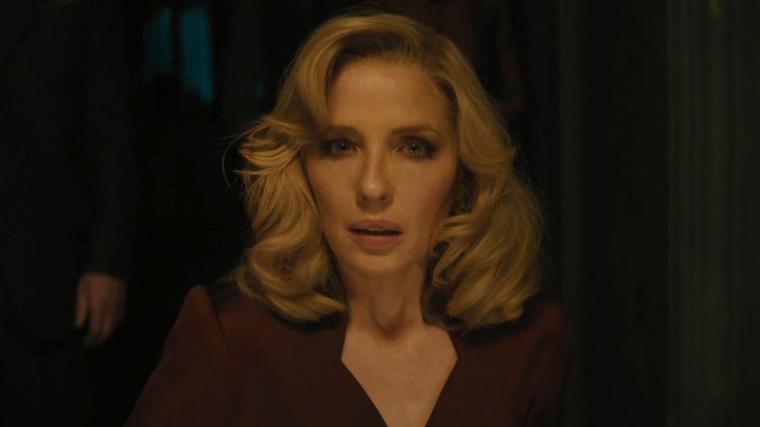
Branagh's visuals accomplish much of the same. With the gifted Haris Zambarloukos serving as cinematographer, A Haunting in Venice's director continually plays with composition in ways reminiscent of Orson Welles in his prime, employing fish-eye lenses, strategic placement of apparently relevant props, disorienting shifts in and out of focus, and more to keep us unsettled even during theoretically mundane scenes of exposition. Nothing here is as self-consciously show-offy as Orient Express' minutes-long overhead shot when the train's corpse was initially studied. Yet just about every sequence boasts some unusual or destabilizing image – a visualized representation of Poirot's newfound internal imbalance. As a director, and despite the melancholy at the tale's core, Branagh appears to be in an intensely playful mood. You hear it in his Poirot readings, especially when bantering with Fey, but Branagh also allows you to see his enjoyment, because it's all there in the incongruous whimsical moodiness of his presentation.
It's also there in the ensemble's collective presence, and in a first for Branagh's Poirot series, there isn't a weak link in the bunch. Fey is basically serving the same function that Phoebe Waller-Bridge did in Indiana Jones & the Dial of Destiny, lightening the period load with modern sass and sarcasm, and she's expectedly winning; between this and Only Murders in the Building, Fey has cemented her status as this September's premier murder-mystery commentator/suspect. With so many characters consumed by grief, Reilly offers a number of affectingly anguished moments at an inconsolate mom, as does Camille Cottin as Rowena's housekeeper, and Jamie Dornan – his mustache nowhere near as ornate as Branagh's – is utterly devastating as a wartime doctor with unspecified PTSD, particularly when relating his experiences tending to recent concentration-camp inmates. (It's safe to say that Dornan, who has been consistently excellent over the past five years, has effectively vanquished all traces of Christian Grey.)
Yeoh is exceptionally entertaining as the debunked psychic whose gifts may nonetheless be genuine, and whose purpose in the story is hardly over following her unmasking. Topnotch work is contributed by Scamarcio as Poirot's enforcer, Emma Laird and Ali Khan as half-siblings with an understandable and unexpectedly moving need for cash, and Kyle Allen as the deceased girl's fiancé who abruptly ended their engagement. And amazingly, though maybe not too amazingly if you saw his previous effort for Branagh, A Haunting in Venice's standout performance might be the one given by Jude Hill, whose unsettlingly mature pre-teen emerges as the only one on-site who could conceivably stand toe-to-toe, though hardly eye to eye, with the tale's legendary detective. This latest Christie is smashingly good on many levels, but I most loved it for the scenes its director/star shares with the frighteningly poised and thoughtful young actor who was effectively Branagh's alter ego in Belfast. It would no doubt mean making it to 90-plus, but I'm gonna try to stay alive 'til then just to see Jude Hill eventually take on the Hercule Poirot role himself.
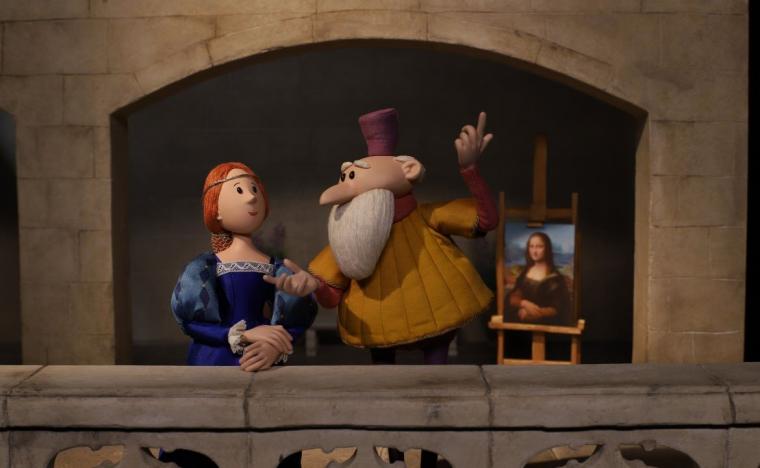
THE INVENTOR
Whatever else it is, and I'm not sure what the hell it is, writer/director Jim Capobianco's The Inventor has to stand as one of the strangest animated movies I've seen in quite a while. It's a 2D animation in the style of classic Rankin/Bass titles from the '60s and '70s, albeit with occasional hand-drawn flourishes and more images of the nude Vitruvian Man than you may anticipate. It's a kid-friendly comedy trafficking in themes of Follow Your Heart and Believe in Your Dreams, yet its subject is Leonardo da Vinci, and requires at least some prior knowledge of his roles as painter and inventor. It's a surprisingly coherent history (and art-history) lesson, but too aggressively designed for small children to entice older kids who might actually get something from the experience. It's a musical that allows Marion Cotillard and Daisy Ridley opportunities to sing, yet one whose principal voice – Stephen Fry's – merely speaks his lyrics in rhythm. It makes no bones about idealizing and canonizing its subject, but doesn't shy from the fact of da Vinci stealing Renaissance-era cadavers for unauthorized, no-doubt-illegal surgical experiments. What, precisely, was the targeted demographic for this thing? Insufferably precocious tykes with an interest in thanatology? Art-minded adults who think Rudolph the Red-Nosed Reindeer would've been improved with more corpses? Parents who wanted their kids out of their hair and figured, “Eh, it's animated – let's drop 'em off and get 90 minutes of peace”?
In other words, it's hard to tell who's going to be the most flummoxed by this miniature blast of weirdness that follows de Vinci from Italy, where Pope Leo X (Matt Berry) is demanding weaponry to use against France, and then to France, where King Francis I (Gauthier Battoue) is less interested in da Vinci's designs for a perfect city than the erection of a statue proclaiming the ruler's greatness. I can't imagine that Capobianco's movie will be in wide release for long, and its beyond-generic title suggests that The Inventor will be quickly lost in the wilderness of options when it begins streaming, which should be any minute now. But if you somehow, accidentally land on this innocuous trifle with disarmingly broad aspirations, I will say that the vocals are roundly terrific, even if the songs aren't. (Whether it's Cotillard and Ridley singing or Fry merely speak-singing, the lyrics are routinely unintelligible.) The da Vinci contraptions in evidence are rather cool-looking, particularly his solving of France's water-supply conundrum. A running gag involving the stealing of freshly dead bodies from a pair of dunderheaded gravediggers could conceivably tickle the grade-schoolers in your household. And it wasn't a grade-schooler in his otherwise completely empty auditorium who audibly chuckled at the movie's image of a Michelangelo who only communicates in grunts and blown raspberries – and this while painting the ceiling of the Sistine Chapel, no less. The Inventor may be confounding, but it sure ain't stupid.
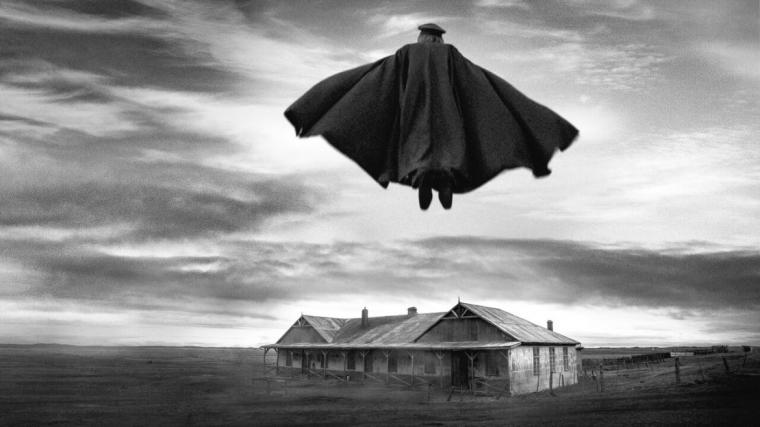
EL CONDE
Yesterday marked the official end of the annual late-summer trifecta of Venice/Telluride/Toronto Film Festivals, which means that we'll soon start seeing the releases of their screened titles – a significant number of Oscar hopefuls among them – both at theaters and on our streaming services. Near as I can tell, the first one out of the gate is writer/director Pablo Larraín's El Conde, which debuted on Netflix this past Friday. The film re-imagines Chilean dictator Augusto Pinochet as a bloodthirsty vampire who faked his 2006 death and now lives in exile on a remote farmstead, making occasional sojourns to the big city whenever he's in need of a heart-and-liver smoothie. It's pretty funny. It's really gross. It's stunningly well-executed. And it makes perfect sense coming from Larraín, whose recent English-language excursions found him turning the presumed bio-pics Jackie and Spencer into horror movies. This time, he's turned a presumed horror movie into a comedy. I'm not sure I'll be on-board with an inevitable presumed comedy that feels like a bio-pic, but if Larraín is at the helm, I'll check it out regardless.
Embarrassing admission: I had no idea who Augusto Pinochet was prior to starting El Conde, and had to pause the film 10 minutes in for a Wikipedia primer. (Such are the humiliations of subscribing to the New York Times for the arts-and-leisure section rather than the international section.) If you're equally ignorant about the Chilean general's role and (dis)honor in his homeland, I urge you to do the same, as backstory can only be helpful in appreciating the feature-length joke of Pinochet (viciously yet soulfully portrayed by Jaime Vadell) unable to choose between death and eternal life as he drags his somehow-more-hateful wife (Gloria Münchmeyer) and five loathsome adult children into the quandary. Unlike Jackie, Spencer, and his 2012 Best Foreign Language Film nominee No, Larraín's latest likely won't be in the running for any Academy Awards – which is too bad, considering that its visual effects, original script (co-written by Guillermo Calderón), and Edward Lachman's black-and-white cinematography should absolutely be in the running. Unlike those other Larraín titles, however, El Conde doesn't turn your mind toward trophies, which are irrelevant in the face of how much demented fun this gory satire proves to be.
Resembling a particularly malevolent, subtitled episode of Succession in which Logan Roy makes literal corpses of his enemies, this straight-faced farce is voracious in demonstrating the greed and avarice of the hangers-on, be they Pinochet's wife, children, or devoted Nazi manservant (Alfredo Castro's Fyodor) whom the lead vampire bit several decades ago. Things also get more complicated, for everyone, when a nun (Paula Luchsinger's Carmen) hired by differing parties as either accountant or exorcist enters the picture, her angelic countenance and no-nonsense demeanor off-set by the image of the young woman dreamily painting her toenails. By this point, though, we've also been alerted to Carmen's potential deviousness by an off-screen British narrator – and it's in the weirdly familiar timbre of Stella Gonet's readings that El Conde lands on its comedic coup de grâce. I adored the film's performances, loved its queasily soothing flying effects, and laughed out loud at a number of throwaway visual gags, among them Pinochet briefly opening his eyes in his casket and Fyodor standing stock still with ketchup and mustard containers in hand. (The sight of the Pinochet siblings and their mother devouring sandwiches is somehow more disgusting than that of their dad feasting on human flesh.) Yet the ultimate revelation of El Conde's narrator is, to date, the sick joke of the 2023 movie year. Read it and weep.










